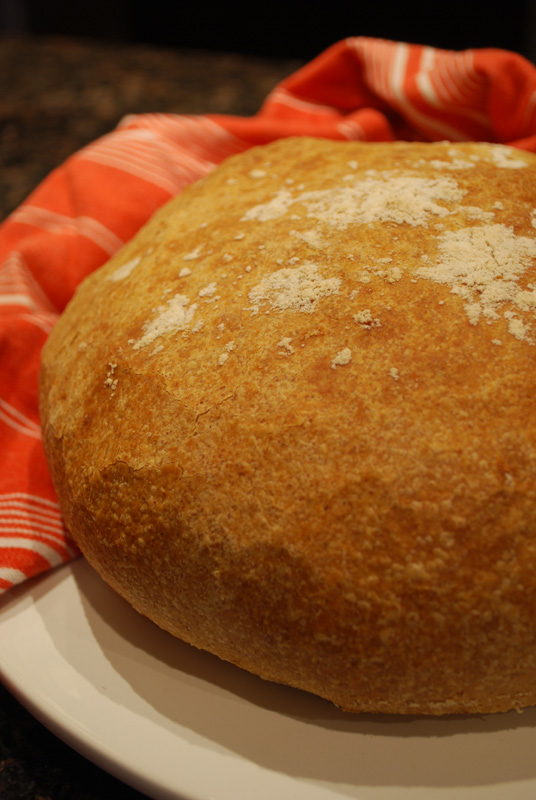Week Six: Italian Breads
Pugliese is Italy’s answer to France’s Pain Rustique. I’m sure that doesn’t mean much to most of you, but they are rather similar. Both use a pre-ferment, both contain whole-grain flour (of any various type), both are fairly wet doughs, and both are amazingly good. First, a pre-ferment is made, also known as a starter. Some of the flour is mixed with some of the water and yeast, and left to get bubbly and flavorful overnight. The next day, that dough is mixed with the remaining ingredients, given a couple of long slow rises, and baked into a gorgeous loaf that is more than the sum of its parts. One important life lesson that bread will teach you is the virtue of patience: the best bread takes time, it simply won’t be rushed. This is one of those breads, one that takes its sweet time, and rewards you at the end with a remarkable flavor, and a toothsome bite, chewy and fragrant with the whole-wheat flour.
Originally from the Puglia region of Italy, in the Southeastern “heel” of the country, one distinguishing characteristic of pugliese is its shape, usually formed into a large round. Pain rustique, on the other hand, is generally formed in a squat baguette shape, called a bâtard. Pugliese is also similar in composition to another bread, the beloved Italian ciabatta. There are two important differences there, though. Pugliese has the addition of whole-grain flour, whereas ciabatta is made with purely white flour. In addition, ciabatta is also shaped differently, into the familiar slipper shape (“ciabatta” means “slipper”).
This recipe for pugliese is actually a rather Americanized version, since in Italy, pugliese contains finely ground durum wheat flour (semolina), rather than our more familiar whole-wheat flour. Some bakeries in Italy even make the bread entirely with durum flour. So if you want true pugliese, this actually isn’t it. But it sure is tasty, and I doubt even the most thoroughly authentic tipo Italiano would turn this down. The crust is rather soft for artisan bread standards, due to the larger-than-usual amount of olive oil, but that makes it easy and wonderful to tear into big, rustic chunks, just right for dipping into a brothy soup, or mopping up the last bits of delicious sauce from your plate of pasta. It also gives a light, fruity note behind the heartiness of the whole grains. If you happen to be hosting a dinner party while the weather is still so cold, this would be an ideal accompaniment to a large pot of vegetable soup. Serve everyone a steamy bowl, put the pugliese in the middle of the table, and break bread with your friends – it will warm them inside and out!
Pugliese
From Bread by Christine Ingram and Jennie Shapter
For the biga:
6 ounces unbleached bread flour (about 1 1/2 cups)
3/4 teaspoon active dry yeast
6 tablespoons lukewarm water
For the dough:
8 ounces unbleached bread flour (about 2 cups), plus extra for dusting
8 ounces whole-wheat bread flour (about 2 cups)
1 teaspoon sugar
2 teaspoons salt
1 1/2 teaspoons active dry yeast
9 fluid ounces lukewarm water (1 cup + 2 tablespoons)
5 tablespoons extra virgin olive oil
1. Sift the flour for the biga into a large bowl. Make a well in the center. In a small bowl, cream the yeast with the water. Pour the liquid into the centre of the flour and gradually mix in the surrounding flour to form a firm dough.
2. Turn the dough out onto a lightly floured surface and knead for 5 minutes until smooth and elastic. Return to the bowl, cover with plastic wrap, and leave to rise in a warm place for 8-10 hours, or until the dough has risen well and is starting to collapse.
3. Sprinkle the yeast over half of the water, and combine. Let sit for 5-10 minutes, or until foamy. If it doesn’t foam, throw it out and start with new yeast. Mix the flours, sugar, and salt for the dough together in a large bowl. Add the biga to the yeast mixture, add the remaining water, and mix together.
4. Stir in the flour mixture a little at a time, then add the olive oil slowly, and mix to a soft dough. Turn out onto a lightly floured surface and knead the dough for 8-10 minutes until smooth and elastic.
5. Place in a lightly oiled bowl, cover with plastic wrap, and leave to rise in a warm place for 1 to 1 1/2 hours, or until doubled in size.
6. Turn out onto a lightly floured surface and punch down. Gently pull out the edges and fold under to make a round. Transfer to a lightly-floured or parchment-lined baking sheet, cover with lightly oiled plastic wrap, and let rise in a warm place for 1 to 1 1/2 hours, or until doubled in bulk.
7. Meanwhile, preheat the oven to 450º F. Lightly dust the loaf with flour and bake for 15 minutes. Reduce the oven temperature to 400º F and bake for a further 20 minutes, or until the loaf sounds hollow when tapped on the bottom. Transfer to a rack to cool completely before cutting.
Notes:
1. I didn’t have whole-wheat bread flour, so I just used regular whole-wheat flour with no problem.
2. I let my dough ferment for about 7 hours, obviously well over the recommended time. The texture was affected by that, certainly (it didn’t rise as much as it should’ve in the oven, and it wasn’t as airy as it should’ve been); but it still came out pretty well, and definitely had a good flavor.

